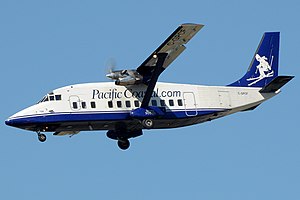The Genesis of the Short Brothers 360
The Short Brothers 360, also known as the SB.360, traces its origins back to the early 1960s. Short Brothers, a renowned British aerospace company, envisioned a new aircraft that would revolutionize regional air travel. With a focus on efficiency, comfort, and versatility, they set out to create a game-changing aircraft that would surpass all expectations.
Design Features and Technological Marvels
One of the most striking features of the Short Brothers 360 is its unique high-wing configuration. This design choice allows for greater stability and enhanced maneuverability, making it an ideal choice for short-haul flights. The aircraft's sleek lines and streamlined fuselage minimize drag, resulting in reduced fuel consumption and increased speed.
Powered by advanced turbofan engines, the Short Brothers 360 delivers an impressive performance. With its powerful thrust and exceptional climb rate, this aircraft ensures a smooth and efficient journey for both passengers and crew. Its state-of-the-art avionics systems and cutting-edge navigational aids guarantee maximum safety and precision during flight.
The Impact on Regional Air Travel
The introduction of the Short Brothers 360 had a profound impact on regional air travel. This versatile aircraft provided airlines with a cost-effective solution for connecting smaller airports and remote communities. With its ability to operate on short runways and in challenging weather conditions, the Short Brothers 360 opened up new possibilities for air travel in previously underserved regions.
Passengers were equally thrilled with the comfort and convenience offered by the Short Brothers 360. Its spacious cabin and ergonomic seating ensured a pleasant flying experience, even on longer journeys. The aircraft's low noise levels and smooth ride further contributed to its popularity among travelers.
Continued Evolution and Legacy
Over the years, the Short Brothers 360 underwent several upgrades and iterations to meet the evolving demands of the aviation industry. Each new model introduced improvements in engine efficiency, range, and passenger capacity, further solidifying its status as a reliable workhorse for regional airlines.
Though newer aircraft have since taken the spotlight, the Short Brothers 360 remains a symbol of innovation and excellence in aviation engineering. Its legacy lives on, reminding us of the remarkable achievements made in the pursuit of safer, more efficient air travel.
In Conclusion
The Short Brothers 360 airplane stands as a testament to human ingenuity and technical prowess. With its groundbreaking design, exceptional performance, and impact on regional air travel, it has undoubtedly left an indelible mark on the aviation industry. The Short Brothers 360 will forever be remembered as a true marvel of engineering, propelling us forward into a future where the sky is no longer the limit.

General characteristics
- Crew: Three (Two pilots plus one cabin crew)
- Capacity: 36 passengers
- Length: 21.58 m (70 ft 10 in)
- Wingspan: 22.81 m (74 ft 10 in)
- Height: 7.21 m (23 ft 8 in)
- Wing area: 42.09 m2 (454 sq ft)
- Airfoil: NACA 63A modified
- Empty weight: 7,870 kg (17,350 lb)
- Max takeoff weight: 12,292 kg (27,099 lb)
- Fuel capacity: 2,182 L (480 imp gal; 576 US gal)
- Powerplant: 2 × Pratt & Whitney Canada PT6A-65AR turboprop, 1,062 kW (1,424 shp) each
Performance
- Maximum speed: 404 km/h (251 mph, 218 kn) (max cruise at FL 100)
- Cruise speed: 330 km/h (210 mph, 180 kn) (Long range cruise at FL100)
- Range: 1,595 km (991 mi, 861 nmi) full tanks, 2,569 kg (5,664 lb) payload
- Service ceiling: 6,100 m (20,000 ft) MSL
- Rate of climb: 4.84 m/s (952 ft/min)
- Fuel consumption: 1.01 kg/km (3.57 lb/mi) 820 lb (370 kg)/h at 200 kn (370 km/h) TAS
